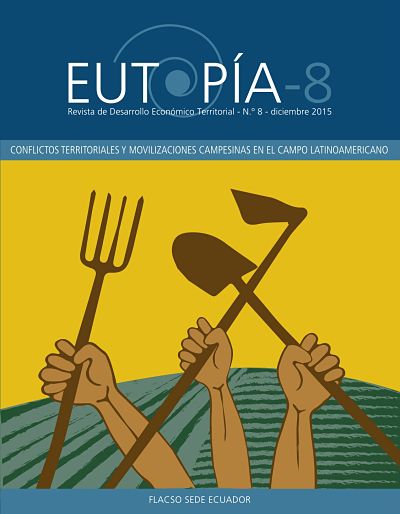Territory and environment in the Peasant Reserve Zones of Colombia
Abstract
This article is based on an original research that focuses on analyzing the concept of environmental land use planning in the Peasant Reserve Zones (ZRC) of Colombia from the perspectives of the State and the peasantry. First, it situates the geographical dimension of the analysis with the concepts of space and territory. Then, it takes conceptual tools from the agrarian question to situate the ZRC as part of an agrarian reform in the 1990s. It emphasizes on how the agrarian question scope has a bias on economic behavior ignoring the sense of territorial construction of proposals such as the ZRC in the frame of State land planning. It illustrates some examples of organizational structures (e.g., local action committees, JAC) and local space dynamics (vereda and Peasant Environmental Units, UACA) to construct its argument. The objective of this article is to articulate economic debates of the agrarian question within a geographic scope focused on territory to analyze how the ZRC are peasant territorial proposals where environmental aspects play a crucial role in negotiating territoriality with the State. Finally, the article invites to a reflection on the meaning of “the environmental” in contemporary peasant struggles.Downloads
References
ANZORC (Asociación Nacional de Zonas de Reserva Campesina) (2014). “Ordenamiento ambiental, derechos campesinos: Ruta para la construcción de paz”. Ponencia presentada en el II Congreso colombiano de áreas protegidas. Áreas protegidas: Territorios para la vida y la paz. Julio 16 de 2014, Bogotá, Colombia.
ACVC y Humanidad Vigente (2010). “La ZRC del Valle del Río Cimitarra”. Disponible en: https://zrcperlaamazonica.wordpress.com/about/ (visitada el 29 de Julio de 2015).
Borras, Saturnino (2003). “Questioning Market-Led Agrarian Reform: Experiences from Brazil, Colombia and South Africa”. Journal of Agrarian Change. Vol.3, pp 367-394.
Corrales, Elsy y Jaime Forero (1993). “La economía campesina y la sociedad rural en el modelo neoliberal de desarrollo en Colombia”. En: Correa, A., González, I. y R.H. Mora (eds). Neoliberales y pobres, el debate continental por la justicia. CINEP, CRT, Centro Gumilla. México.
Estrada Álvarez, Jairo, Juan Guillermo Ferro Medina, Rubin Huffington Rodríguez y Johanna Herrera Arango (2013). Territorios Campesinos, la experiencia de las zonas de reserva campesina. Bogotá: Editorial Universidad Nacional de Colombia.
Hernández, Luis Humberto (2013). “Dimensiones Históricas y Socio-económicas del Conflicto Armado en Colombia”. En Diálogos de La Habana: Miradas Múltiples desde la Universidad, pp. 17-58, Alejo Vargas Velásquez, editor. Bogotá: Universidad Nacional de Colombia.
INCODER, ILSA, SINPEAGRICUN (2012). Zonas de Reserva Campesina. Elementos Introductorios y de debate. Bogotá: Gente Nueva editorial.
Ley 160 de 1994 (1994). Por medio de la cual se crea el Sistema Nacional de Reforma Agraria y Desarrollo Rural Campesino, se establece un subsidio para la adquisición de tierras, se reforma el Instituto Colombiano de la Reforma Agraria y se dictan otras disposiciones. Bogotá: Ministerio de Agricultura y Desarrollo Rural.
Londoño Botero, Rocío (1997). “Los sindicatos y las juntas de acción comunal en Colombia.” América Latina Hoy. No.17, pp. 87-102.
Lefebvre, Henri (1991). The production of space. Blackwell Publishing. Oxford.
Leff, Enrique (2004). Racionalidad Ambiental. La reapropiación social de la naturaleza. México: Siglo veintiuno editores.
Machado, Absalón (1998). La cuestión agraria en Colombia a fines del milenio. Bogotá: El Áncora Editores.
Ministerio del Medio Ambiente (1998). Lineamientos para la Política Nacional de Ordenamiento Ambiental del Territorio. Bogotá: Oficina Asesora de Ordenamiento Ambiental –Ministerio del Medio Ambiente.
Ortiz Guerrero, Cesar Enrique, Manuel Enrique Pérez Martínez, Daniel Castillo Brieva y Luis Alfredo Muñoz Wilches (2004). Zonas de reserva campesina. Aprendizaje e innovación para el Desarrollo Rural. Bogotá: Pontificia Universidad Javeriana JAVEGRAF.
Ruiz Reyes, Manuela (2015). In Search of Ordenamiento Ambiental Territorial in the Peasant Reserve Zones of Colombia. Tesis de maestría. Syracuse: Syracuse University.
Raffestin, Claude (1982). “Remarques sur les notions d’espace, de territoire et de territorialité”. Espace et Sociétés. No. 41, pp. 167-171.
Wolford, Wendy (2007). “Land Reform in the Time of Neoliberalism: A Many-Splendored Thing”. Antipode. Vol. 39, No.3, pp. 550-570.
Copyright (c) 2015 Manuela Ruiz Reyes

This work is licensed under a Creative Commons Attribution-NonCommercial 4.0 International License.

Eutopía, Revista de Desarrollo Económico Territorial, operates under Creative Commons Attribution-No Derivative Work 3.0 unported (CC BY-ND 3.0).
The authors who publish in Eutopía accept these terms:
You are free to share / copy and redistribute the material in any medium or format for any purpose, including commercial. Therefore, authors retain the copyright and cede to the journal the right of the first publication (CC by-ND 3.0), which allows third parties the redistribution, commercial or noncommercial, of what is published as long as the article circulates without changes.
The following conditions exist for the authors:
Recognition - you must recognize the authorship, provide a link to the license and indicate whether changes have been made. You can do this in any way reasonable, but not in a way that suggest that has the support of the licensor or receives it by the use he makes.
Without Derivative Work – If you remixed, transform or create a work from the original material, you cannot broadcast the modified material.
For more details, visit the page of Creative Commons (CC).


























